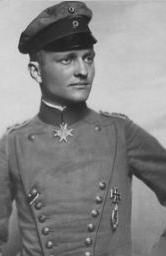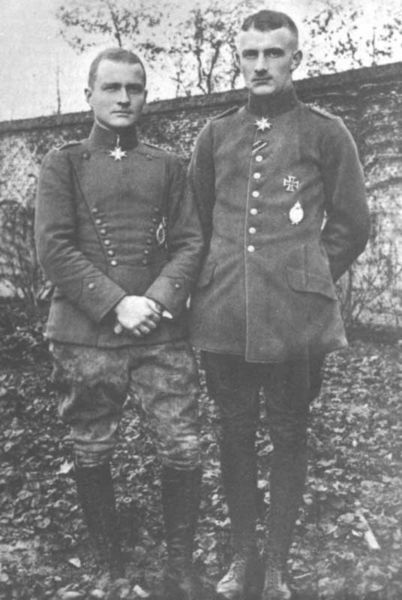Manfred von Richthofen
From Kaiserreich
MaskedPickle (Talk | contribs) |
MaskedPickle (Talk | contribs) |
||
| Line 21: | Line 21: | ||
== Personal life == | == Personal life == | ||
| - | Richthofen is still suffering of headaches from his head wound on July 1917, and also from the unfortunate death of his brother Lothar in 1920. Despite the rumors of an affair with successful female pilot Amelia Earhart, nobody knows him any relationship, wedding or child. A personnal friend of the Kaiser, he used to make exhibition flights, for official ceremonies, parades or even inaugurations. Some analysts are even seeing him as a possible | + | Richthofen is still suffering of headaches from his head wound on July 1917, and also from the unfortunate death of his brother Lothar in 1920. Despite the rumors of an affair with successful female pilot Amelia Earhart, nobody knows him any relationship, wedding or child. A personnal friend of the Kaiser, he used to make exhibition flights, for official ceremonies, parades or even inaugurations. Some analysts are even seeing him as a possible Reichskanzler due to his popularity, but he has been too compromised by the extreme positions of his friend and former collegue [[Hermann Goering]]. |
=== Family === | === Family === | ||
Revision as of 13:36, 25 January 2008
Manfred Albrecht, Freiherr (Baron) von Richthofen (born in May, 2 1892 at Kleinburg, Germany), better known as the Red Baron (Der Rote Baron in German), is a German fighter pilot. He is famous of being the most successful flying ace of the Weltkrieg with 80 confirmed air combat victories, the first German Generalfeldmarschall coming from the Air Force, and the current Chief of the Luftstreitkräfte, more precisely his founder as an integrant part of the German army.
Contents |
Biography
Early life
Manfred von Richthofen was born in Kleinburg, near Breslau, in Silesia, in the well-known family of old Prussian nobility (see below). Moving to the nearby Schweidnitz at 9, the young von Richthofen enjoyed horse riding and hunting: after completing cadet training in 1911, he joined the cavalry unit Ulanen-Regiment Kaiser Alexanders des III. von Russland (1. Westpreußisches). When the Weltkrieg broke out, he served as a cavalry scout in both eastern and western fronts: with the cavalry becoming obsolete with the use of machine guns and barber wire, von Richthofen soon became disappointed to not being able to participate more often in combat operations, and asked for a transfer to the young Luftstreitkräfte (Flying Service): his request was granted and he joined it at the end of May 1915.
The Flying Circus
Initially a reconnaissance observer over the Eastern Front from June to August 1915, Richthofen managed to shot down a French Farman with his observer's machine gun, but the kill was not credited as it felt behind the enemy lines. Trained as a pilot in October 1915, he joined in March 1916 the Kampfgeschwader 2 with an Albatros B.II, and later and a Fokker Eindecker, he participated to the battle of Verdun, shooting another French aircraft for which he gained no credit. After his meeting with fighter pilot Oswald Boelcke, who selected him to join the Jasta 2, Richthofen registered his first aerial victory above Cambrai on September, 17 1916. From then, he used to receive a silver cup with the date of the victory: he continued until he had 60 cups, due to the silver restriction in Germany at that date. Engaging in risky tactics like his brother Lothar, he comptabilized more than 80 victories, even managing to shot down his British rival, Major Lanoe Hawker, described by Richthofen himself as "the British Boelcke". Switching between different planes, he gained his reputation as "The Red Baron" with his bright red Albatros D.III, painted as that for better recognition during air combat.
"Der Rote Baron"
In January 1917, after his sixteenth confirmed kill, Richthofen was invited by the Kaiser Wilhelm IIhimself to a dinner, and received the Pour le Mérite, the highest military honor in Germany. On the same month, he assumed command of the Jasta 11, composed of pilots whom he trained himself, painting their planes in the same red that his own, in order to be better recognized. The point is that the air melees, risky and taking place in an unknown ground, had something of chivalrous and beautiful, when in the same time thousands of soldiers were dying every day in the muddy trenches. Achieving 22 victories over British aircrafts during the only month of April 1917. On July, 6 1917, he was wounded on the head near Wervicq, grounding him for several months. During his convalescence, he wrote (certainly with the help of a ghostwriter)his autobiography, Der rote Kampfflieger. After this episode, he became some sort of legend for both sides, with propaganda claiming that the British air forces raised special bataillons to shot him down, and the German propaganda services were fearing that his death could give a fatal blow to the German morale. After a risky engagement above Somme River on April, 21 1918, the Kaiser himself give instructions to ground him, only giving him nominal commandments until the end of the Weltkrieg. Since then, he assumed his role of figurehead in the hearts of many Germans galvanized by the stories of his engagements, and was militantly in favour of the creation of a true German Air Force; using his popularity, Reichkanzler von Tirpitz created officially the Luftstreitkräfte in February, 13 1925, naming von Richthofen as his chief, a post to which he was never removed since eleven years. His popularity was achieved when the Kaiser insisted to give him the rank of Generalfeldmarschall in May 1932, being the first person coming from the Air Force to achieve such a prestigious title.
Personal life
Richthofen is still suffering of headaches from his head wound on July 1917, and also from the unfortunate death of his brother Lothar in 1920. Despite the rumors of an affair with successful female pilot Amelia Earhart, nobody knows him any relationship, wedding or child. A personnal friend of the Kaiser, he used to make exhibition flights, for official ceremonies, parades or even inaugurations. Some analysts are even seeing him as a possible Reichskanzler due to his popularity, but he has been too compromised by the extreme positions of his friend and former collegue Hermann Goering.
Family
The Richthofen family, yet linked with royal families due to their past of illegitimate sons of Prince Leopold of Anhalt-Nassau, has several prestigious persons within her, along with Manfred himself: his younger brother, Lothar, fought also in the Air Force during the Weltkrieg, achieving 40 victories and died over Britain in 1920, shot by an ANZAC anti-aerian shooter. Their cousin, Wolfram, is also having a great carrier in the Luftstreitkräfte. Manfred's uncle was geographer Ferdinand von Richthofen.
Military career
• Cavalry - Ulanen-Regiment Kaiser Alexanders des III. von Russland (1. Westpreußisches) - Rittmeister: 1911-May 1915
• Flying Service - No. 69 Flying Squadron - Reconnaissance observer : June-August 1915
• Flying Service - Kampfgeschwader 2 - Pilot : March 1916-August 1916
• Flying Service - Jagdstaffel 2 - Pilot : August 1916-January 1917
• Flying Service - Jagdstaffel 11 - Commander: January 1917-July 1918
• Flying Service - Jagdgeschwader 1 - Commander: July 1918-April 1920
• Flying Service - Generaloberst: November 1923
• Flying Service - Chief: February 1925
• Generalfeldmarschall: May 1932
Decorations and awards
• Prussian Pour le Mérite Order: 12 January 1917 (in recognition of his 16th aerial victory).
• Prussian Red Eagle Order, 3rd Class with Crown and Swords: 6 April 1918 (in recognition of his 70th aerial victory).
• Prussian Royal Hohenzollern House Order, Knight’s Cross with Swords: 11 November 1916.
• Prussian Iron Cross, 1st Class (1914)
• Prussian Iron Cross, 2nd Class (1914): September 1914.
• Bavarian Military Merit Order, 4th Class with Swords: 29 April 1917.
• Saxon Military St. Henry Order, Knight’s Cross: 16 April 1917.
• Württemberg Military Merit Order, Knight’s Cross: 13 April 1917.
• Saxe-Ernestine Ducal House Order, Knight 1st Class with Swords (issued by the Duchy of Saxe-Coburg and Gotha): 9 May 1917.
• Hesse General Honor Decoration, “for Bravery”
• Lippe War Honor Cross for Heroic Deeds: 13 October 1917.
• Schaumburg-Lippe Cross for Faithful Service: 10 October 1917.
• Brunswick War Merit Cross, 2nd Class: 24 September 1917.
• Saxe-Coburg and Gotha Duke Carl Eduard Medal, 2nd Class with Swords and Date: 30 December 1916
• Hamburg Hanseatic Cross
• Bremen Hanseatic Cross: 25 September 1917.
• Lübeck Hanseatic Cross: 22 September 1917.
• Austrian Order of the Iron Crown, 3rd Class with War Decoration: 8 August 1917.
• Austrian Military Merit Cross, 3rd Class with War Decoration
• Bulgarian Bravery Order, 4th Class (1st Grade): June 1917.
• Turkish Imtiaz Medal in Silver with Sabers
• Turkish Liakat Medal in Silver with Sabers
• Turkish War Medal (“Iron Crescent”): 4 November 1917.
• German Army Pilot’s Badge
• German Army Observer’s Badge
• Austrian Field Pilot’s Badge (Franz Joseph pattern)
His nickname
Von Richthofen was, during the Weltkrieg, rarely referred to as "Baron", but as Freiherr, his correct title of nobility. His 1917 autobiography was titled "Der Rote Kampfflieger, translated by J. Ellis Barker in 1918 as The Red Battle Flyer. His nickname is known as "Der Rote Baron" in German, "the Red Knight" or "the Red Baron" in English, and "le Diable Rouge" or "Le Petit Rouge" in French.



